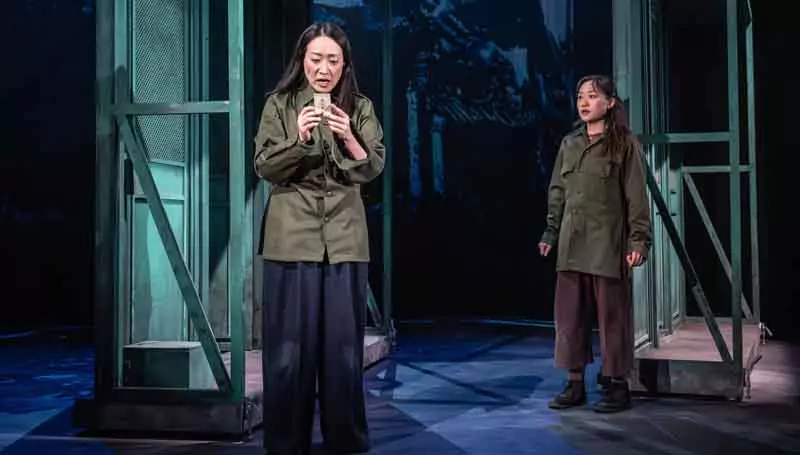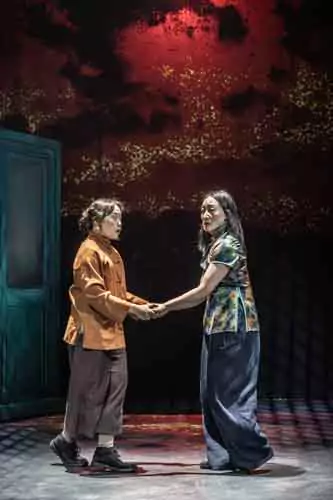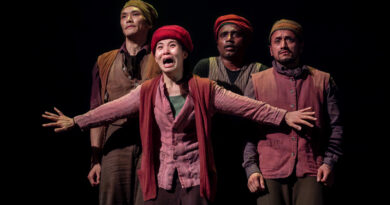“Shanghai Dolls” at Kiln Theatre
Neil Dowden in North London
13 April 2025
A British–Hong Kong author, Amy Ng was a political historian before writing several plays with a Hong Kong-related theme. Her latest is set on mainland China between 1935 and 1991. Shanghai Dolls – a co-production by Kiln Theatre and Paines Plough – focuses on the fluctuating relationship between two women who go on to have a significant impact on Chinese society: Jiang Qing (better known as Madame Mao), who as the fourth wife of the country’s leader was the driving force behind the Cultural Revolution, and Sun Weishi, who became the first Chinese female theatre director. It’s a fascinating story of a cultural oppressor and a cultural martyr amidst a turbulent political background, but the play doesn’t make the most of its rich material.
Millicent Wong and Gabby Wong.
Photo credit: Marc Brenner.
They meet in Shanghai in 1935 during conflict between the Communists and Kuomintang with the Japanese army threatening. Jiang (under the stage name Lan Ping) is rehearsing for the part of Nora in Ibsen’s A Doll’s House at the HQ of the League of Chinese Left-Wing Dramatists, while the doll-carrying 14-year-old Sun (then using the pseudonym Li Lin) is looking for a safe house. After bonding they set up home together, with Sun also becoming an actress, but their paths diverge after Jiang marries Mao, while Sun had earlier been adopted by Mao’s number two Zhou Enlai (her own father had been executed by the KMT).
With the formation of the People’s Republic of China following Communist victory in the civil war, Sun becomes a successful director, while Jiang bides her time until the start of the Cultural Revolution in 1966 when she exercises her power with ruthless force as Sun becomes one of her victims. Ten years later after Mao’s death Jiang herself falls from grace as one of the Gang of Four and eventually commits suicide in prison in 1991.
Covering over 50 years of momentous background history in a 75-minute two-hander is a tough challenge, and though Ng concentrates very much on the female protagonists their deteriorating relations can’t be understood without the context so there is necessarily rather a lot of exposition. It’s also inevitably episodic with eight short scenes (plus a coda), which start at one-year intervals with longer time lapses later on. Although as a former historian Ng has evidently thoroughly researched the period, there isn’t the same access to archives in China as there is usually in the West, so detailed knowledge is limited and she takes artistic licence to speculate on what happened between the women.
The play doesn’t give a clear-cut answer as to why Jiang turned so much against Sun after such a close friendship when they were both young. Despite Sun losing her father as a child, Jiang regards her as privileged because of Zhou’s protection – she brands her a “red princess” – compared to her own poor, abusive family upbringing (though of course she later outdoes that by marrying Mao). Jiang also had a fling with actor Jin Shan (“China’s Clark Gable”) before Sun falls in love with him and becomes his wife, while Jiang claims she doesn’t blame Sun for being forced to have sex with her husband Mao. She also claims Sun rejected her suggested projects for artistic collaboration. The hostility seems to come from a mixture of personal jealousy and political enmity, with Mao regarding Zhou as a potential rival.
The evolution of Jiang into the monster Madame Mao is not very convincingly done. In the pre-war scenes she is portrayed as a free-spirited, pleasure-seeker enjoying the vibrant nightlife of 1930s Shanghai who posed for a Coca-Cola advert, as well as “an actress [who] ain’t no doll to be pushed around, but an artist in her own right”. (In contrast Sun – seven years younger – passively follows the party line.) But as a somewhat scandalous, “debauched” figure she is only allowed by the party to marry Mao on condition she keeps out of politics for 30 years while tending to her husband’s needs. “They put me right back in the doll’s house.” Ng provocatively suggests that Jiang’s frustrated feminism as a “revolutionary artist” was later perverted into vengeful abuse of power.
Katie Posner’s fluid production is aided by Jean Chan’s flexible design of portable tarnished green doorways that are moved around the stage to suggest different settings. Akhila Krishnan’s video images and captions – including newspaper headlines – play a major role in signifying location, time, and tumultuous historical events. Aideen Malone floods the stage with red lighting to evoke Mao’s disastrous 1958 Great Leap Forward and resulting famine, while Nicola T. Chang’s ominous music indicates Sun’s torture and rape in captivity. The newsreel footage of the defiant Madame Mao shouting at her trial while those in court mock her by laughing still sends a shiver down the spine.
Gabby Wong plays the young Jiang with free-wheeling energy as she rails against the patriarchy and advocates for sisterhood, then rather awkwardly transforms into the bespectacled, uniformed Madame Mao who exudes inscrutable vindictiveness when vowing to smash the so-called “cultural establishment”. Millicent Wong’s Sun develops from naïve, frightened girl (though difficult to believe she would straightaway start coaching Jiang how to play Nora!) to self-assured director creating truly revolutionary theatre with the workers, who refuses to compromise the freedom of her artists and pays the ultimate price.










